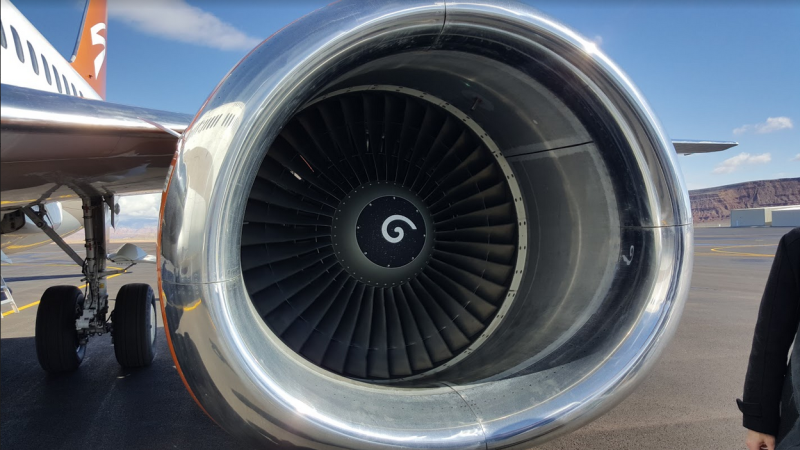
If you’ve ever traveled on a commercial airplane, there’s a likely chance you’ve noticed those little white swirls in the center of those engines on the wings. It may seem straightforward: to keep people on the ground advised when the turbofan is spinning, right? But that doesn’t explain everything.
To learn more about nosecone spirals—also called spinner spirals, spinner swirls, or nosecone swirls—I emailed Boeing, whose spokesman responded with:
…the nosecone spirals serve two purposes: one is to scare birds and the other is to identify when the engine cone is spinning.
This agrees with what Rolls Royce—a leading maker of jet engines—had to say as well. They described how the swirls fend off birds, saying:
Our aerospace engines have swirls painted onto their spinners in order to indicate when the engine is rotating while on the ground. In flight these swirls flicker as the engine rotates at high speed, scaring birds and allowing them to fly clear of the engine.
So to warn ground crews and to ward off birds—seems plausible. But while two solid sources like Boeing and Rolls Royce being in agreement might make you think we’re done here, there’s actually quite a bit of conflicting information on all this.
Advertisement
Bird Strike Protection
There’s a lot of conflicting information about the swirl’s value as a bird-strike prevention mechanism. For example, Boeing’s representative told me that one of the swirl’s functions is to “scare birds,” but if you look at this article in Boeing’s own Aero Magazine, co-written by a Ph.D. in Aviation System Safety and a safety pilot, it says that’s not true.
Advertisement
In its “Common Misconceptions About Bird Strikes” section, the article includes “airplane colors and jet engine spinner markings help to repel birds.”
Adding to confusion, despite Rolls Royce’s press release suggesting that the swirl’s “flicker” when it rotates repels birds, online aviation blog AeroSavvysays it received the following statement from Rolls Royce:
The nose cone (both in terms of strength and angle) is designed to reduced bird impact damage to the engine and reduce ice build-up. The spirals are there as a warning to ground crew when taxiing… In flight, the spirals could not be seen by birds as the rotation of the engine would be too fast.
Advertisement
So it appears that both Boeing and Rolls Royce contradict themselves on this point.
I’ve come across plenty of other sources, including this Luftahansa Chief Pilot, that say the swirls help keep the fowls at bay.
But unfortunately, as AeroSavvy points out, aside from a study mentioned in the New York Times about a Japanese airline that seems to have reduced bird strikes by painting “eyes” on Boeing 747 and 767 aircraft—and another small study on zebra-pattern propellors that appeared to have reduced bird strikes in Norway—there’s really not a lot of conclusive, hard research proving the spinner swirl’s worth as a bird strike preventer.
Advertisement
A Visual Cue For The Ground Crew
Pretty much any source that I’ve come across agrees that the spinner spiral is there to warn the ground crew that the engine is still rotating, so that the person de-icing the airplane or removing your luggage doesn’t walk too close and get sucked into the intake like this poor guy did.
Advertisement
This makes a lot of sense. If you look at the blades of an ordinary desk fan, you’ll notice that, at high fan speeds, the blade looks like an almost transparent blur. At night, and especially under LED lighting, that fan can actually appear stationary.
Dutch airline KLM, in its article about spinner swirls, expounds upon why it’s not always easy for the ground crew to know if an engine is still operating, saying:
“Can’t ground staff hear the deafening roar of a running jet engine?” I hear you wonder. Well, there could be several engines running at once near ground crew, plus they wear hearing protection. If five engines are singing in your ears, it isn’t always obvious which is running and which isn’t.
Advertisement
The post discusses how the spiral helps solve that problem:
If an engine is running, you see a white blur or a hypnotising twirl, depending on the rotation speed of the engine. This visual cue is extremely clear and warns everyone on the apron to stay away from the huge jet engines.
This closer look at that “hypnotizing twirl” really helps you visualize how much this feature can help:
In its excellent comprehensive article “Aircraft Engine Spirals & Swirls,” AeroSavvy talks about just how dangerous it can be if someone in the ground crew gets too close to a turbofan:
Working near a running jet engine is extraordinarily dangerous. A Boeing 737 engine, running at idle power, has a hazard zone of 9 feet to the front and sides of the engine.
This means that, even at idle thrust, a human that walks in the hazard area runs the risk of being sucked inside and consumed by the engine. When the engine is above idle thrust, the hazard zone increases to 14 feet or more. Engines on larger jets, like the 777 have much larger hazard zones. It is absolutely critical that ground crews can identify a running engine and stay away from it.
Advertisement
So very clearly, the spiral is an important feature for helping keep the ground crew safe—pretty much every source out there agrees, here, and it makes a lot of sense. As for the bit about bird strikes, there doesn’t appear to be much conclusive data showing that swirls keep the birds away.
At the very least, ground crews are probably happy it’s there.













